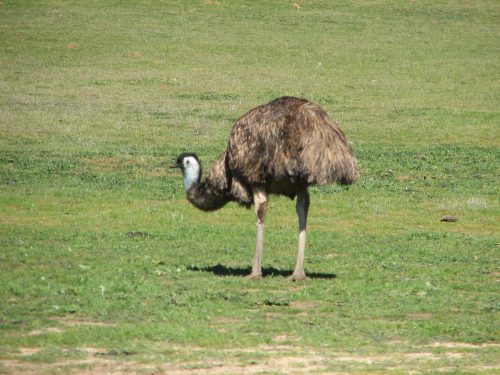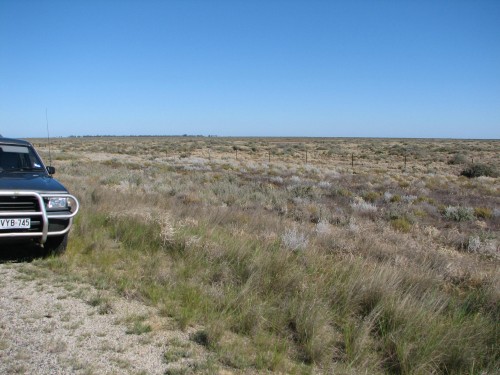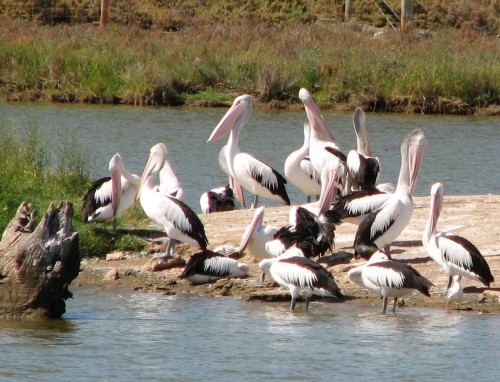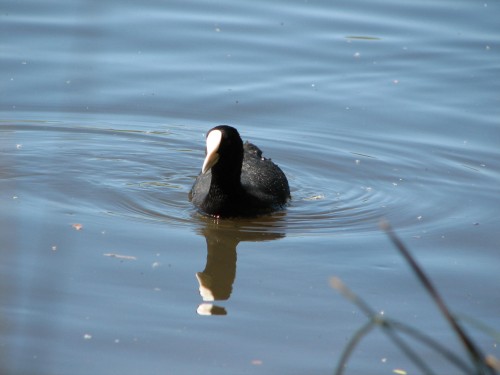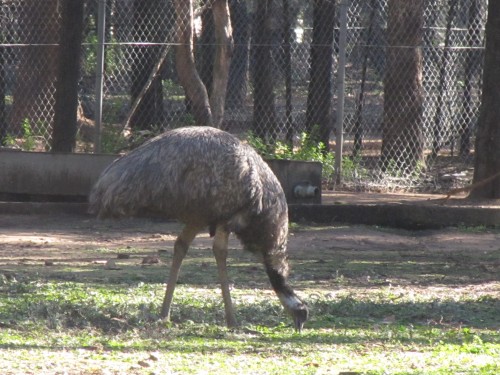Where are all the Emus?
Recently we began another road trip, once again visiting family in Sydney. From home in Murray Bridge, South Australia, it is just over 1300 kilometres or about 14 hours actual travelling time. Whenever we stop, I try to jot down a list of all of the birds I see or hear. When it is my wife’s turn to drive, I am able to concentrate on the birds I see as we are driving along, listing them in my notebook as I see the birds. Sometimes, if I see something unusual, or noteworthy, I will even ask my wife to note this in my notebook when I am driving. She is great that way – and she even points out birds I may have missed.
On all of our trips over to Sydney, I particularly enjoy crossing the Hay Plains between the towns of Balranald and Hay. To most people, this is a dreary, featureless plain covered by saltbush. We find it endlessly fascinating, watching the subtle changes in vegetation as well as the birdlife along the way. On this trip, we saw quite a few birds of prey, something which is not surprising due to the frequent encounters with roadkill. Many kangaroos, rabbits and foxes are killed by the hundreds of trucks traversing this route day and night. We saw plenty of Black Kites, Black-shouldered Kites and Nankeen Kestrels but no Wedge-tailed Eagles which is surprising.
Of particular note, however, was the lack of Emus. Normally we see dozens of this species, sometimes more than a hundred, often in small, loose flocks of 5 to 10 birds. Occasionally, we even see a male Emu followed by a group of up to a dozen immature birds. (The male incubates the eggs and cares for the young for up to 6 months after hatching.)
This time the grand total of Emus was one. In fact, it was the only Emu for the entire 1300km journey.
I cannot account for the absence of Emus on this trip. Perhaps there was no food for them near the road, or they are nesting away from the road. Maybe we will see more on our return trip in three weeks’ time.
Further reading:
- Emu article on Birds in Backyards site – plenty more information about this species.
- Young Emus
- Emu at Adelaide Zoo
- Baby Emus come to drink
- Do Emus Swim?
Surprising waterbirds of the dry country
Dry Country
I love the dry country we have here in Australia. Most of my birding has been done in areas of Australia which have an average annual rainfall of under 250mm (10 inches). Some of this country is marginal farming country, sometimes cereals, and often sheep and cattle. I grew up on such a farm and still cherish my childhood adventures in the mallee bushland near my home.
On the road again
Earlier this week my wife and I travelled from our home in Murray Bridge, South Australia, to Sydney. We are currently staying with my son and his family. The grandchildren love having us stay with them. At ages 7 and 4 they are already showing an interest in the birds they see in their garden, and in the parks they visit. My interest has rubbed off on them.
Missing out
The car journey from home to Sydney is over 1300km, two long days of driving. In future, we think we might take three or four days to get here, stopping more frequently at the many interesting places along the way. There are many national parks, reserves, botanic gardens and bushland on this route and we just have to drive right on by, often with a groan of despair at what we might be missing.
Hay Plains
One of the places we drive through is the large rural town of Hay, located on the banks of the Murrumbidgee River. The birding along this river can be excellent. But before we get to Hay we have to pass through about 130 kilometres of the Hay Plains, a dry region consisting of few trees, much saltbush and some grassland. I find this drive to be fascinating because it often reveals odd collections of birds. On one trip we saw hundreds of Emus grazing on the low vegetation. On another trip, after heavy rain in that area, we saw thousands of ducks, mostly Australian Wood Duck and Grey Teal. They were taking advantage of the long stretches of water still lying along the edges of the highway.
Surprising Waterbirds
As we travelled along at 110kph my wife suddenly pointed out an interesting sight. It was a gathering of dozens of waterbirds: Australian Pelicans, White Ibis, Straw-necked Ibis and Yellow-billed Spoonbills. Harassing all of them from only several metres overhead was a Swamp Harrier. As we rushed by I didn’t have time to take in the presence of any other birds. I am sure that if we had had the time to stop, I would have recorded several species of ducks, perhaps coots, swamphens, egrets, herons and lapwings, cormorants, and maybe even some crakes and rails.
Irrigation
This was a very surprising collection of birds for what is essentially very dry country. The reason for their presence is explained by the presence of wide irrigation channels. The water is pumped from the nearby Murrumbidgee River into a series of channels, some of which are 5 or more metres wide. The water is then used to either flood irrigate large expanses of land, or pumped through long, overhead sprinkler systems. This area grows large amounts of hay, wheat and cotton, all irrigated from the channels. The fact that this also provides a perfect environment for numerous birds is a pleasant by-product. Further east there are large expanses of fruit orchards as well.
Further reading:
- Australian Pelicans overhead
- White Ibis at Dubbo Zoo
- Straw-necked Ibis Adelaide Zoo
- Yellow-billed Spoonbills and the birth of a birder
Emu at Dubbo Zoo
It is always good to see an Emu, one of Australia’s iconic birds while travelling around this wonderful country of ours. There have been many times when we have seen literally hundreds of these large birds in the one place. At other times we only see them singly, or in small loose flocks up to a dozen or so.
When travelling from home in Murray Bridge, South Australia to visit family in Sydney we are always on the lookout as we travel across the Hay Plains. Sometimes we see none at all; on other occasions we have seen hundreds, including many young birds following their father. (The male hatches the eggs and cares for the young for about their first 18 months of life.)
The bird in the photo above was a single individual on the side of the road we travelled through the open range zoo, the Western Plains Zoo at Dubbo in central New South Wales. I don’t know if this bird is a captive bird making up a part of the display of animals in the zoo, or if it is a wild bird that has adapted to the easy life inside the zoo perimeter. Whatever the situation, it was quite at ease in its environment and not at all concerned about our car driving along just a few metres away.
The Trillers are here
There has been an interesting development in the bird life in our garden this last week. The male White-winged Triller is still around every day. calling endlessly and in between calls, feeding on the various caterpillars and other tasty morsels available on our trees and shrubs.
Today he has been joined by a female. She is a duller brown colour, not the striking black and white of the male. So far I’ve not been able to get a photo of her. I saw them feeding together in the same tree. I will be watching for any interesting developments between these two over the coming days.
Related article:
What a thriller – it’s a White-winged Triller
I had just hung out the washing this morning and was on my way back inside. A different bird call drew my attention so I raced inside for the camera and binoculars. Sure enough, we had a male White-winged Triller in our small patch of mallee scrub. This species is an irregular visitor here, usually in the spring or summer.
White-winged Trillers can be seen throughout most of mainland Australia and northern Tasmania. In my experience they are widespread but not common, and certainly not found in large numbers, usually seen singly or in pairs. They also occur in Papua New Guinea and Indonesia. They are a breeding migrant in the southern parts of the country. In the winter months they spend time in the northern and inland regions.
The call is a rich, far reaching, descending ‘chip-chip-chip-joey-joey-joey.’
Related articles:
